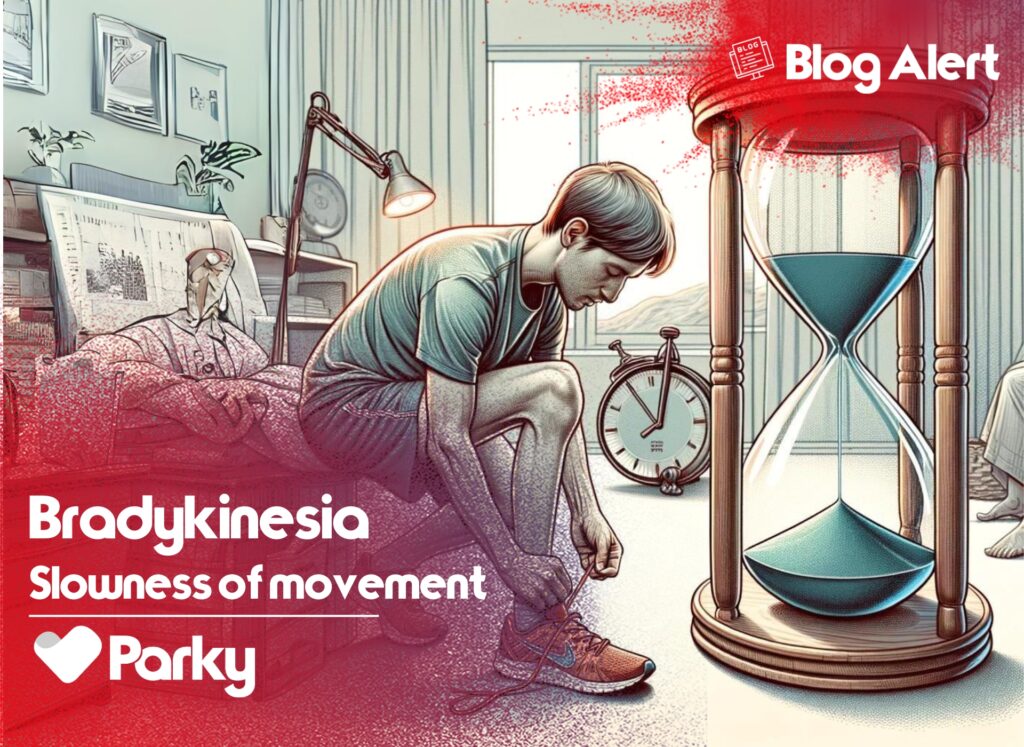

Bradykinesia, pronounced as bray-dee-ki-nee-zee-uh, is a medical term describing slowness of movement. It's a central feature of Parkinson's Disease. The word is derived from two Greek words: "bradys," meaning slow, and "kinesis," meaning movement. In PD, bradykinesia results from disruptions in the brain's signaling processes, leading to impaired control over movement.
It feels like trying to move through thick syrup. Once-simple tasks, such as writing, dressing, or turning in bed, become laborious and time-consuming. Patients often describe a sense of heaviness in their limbs, as if gravity has intensified, making each movement a deliberate effort. This slowness not only challenges physical abilities but also takes a toll on mental well-being due to the frustration and loss of independence it brings.
Bradykinesia and dyskinesia are both terms related to movement disorders, but they represent distinct aspects of motor dysfunction.
Bradykinesia, as discussed earlier, refers to slowness of voluntary movements and is a hallmark symptom of Parkinson's Disease. It involves a significant reduction in the speed and amplitude of voluntary movements. Patients struggle with tasks that were once effortless due to their diminished ability to initiate and execute movements.
Dyskinesia, on the other hand, is characterized by involuntary, abnormal, and often excessive movements. It's a complication often associated with long-term use of medications like levodopa, which are used to manage Parkinson's symptoms. Dyskinesias can manifest as twisting, writhing, or jerky movements, which can be quite distressing for individuals with Parkinson's.
Bradykinesia and hypokinesia share similarities in that they both involve reduced movement, but they have different underlying causes and implications.
Bradykinesia is the slowness of voluntary movements seen in conditions like Parkinson's Disease. It results from disruptions in the brain's signaling processes, particularly due to dopamine deficiency.
Hypokinesia, on the other hand, refers to a reduction in the amplitude or overall quantity of movement. While bradykinesia focuses on the speed of movement, hypokinesia emphasizes the decrease in the extent of movement.
This can manifest as reduced arm swing while walking, decreased facial expressions, or a limited range of motion. In Parkinson's Disease, both contribute to the overall motor impairment, affecting an individual's ability to perform daily activities. Recognizing these differences can help healthcare professionals tailor treatment plans effectively.
Akinesia and bradykinesia are terms related to the impairment of movement, but they have distinct characteristics and implications.
Akinesia, often in advanced Parkinson's stages, is the temporary absence or extreme reduction of voluntary movements, leading to freezing episodes. Bradykinesia, while related, is the overall slowness of movement.
Managing akinesia may involve "unfreezing" techniques, whereas bradykinesia focuses on addressing daily movement slowness.
To diagnose and monitor bradykinesia, healthcare professionals use various tests and assessments. Some common tests include:
These tests aid in diagnosing and tracking the progression, enabling healthcare providers to tailor treatment plans effectively.
Commonly prescribed medications, such as levodopa, help replenish dopamine levels and alleviate symptoms. Physical therapy and tailored exercise plans play a crucial role in maintaining mobility and preventing muscle stiffness.
Here is an example exercise published by Power for Parkinson's: a non-profit organization providing free online mind and body fitness classes.
Assistive devices and adaptive strategies, like larger grips on utensils or shoes with Velcro straps, make daily activities more manageable. Complementary therapies like dance, yoga, and acupuncture have shown promise in alleviating symptoms and improving overall well-being. However, these should be discussed with healthcare professionals for personalized recommendations.
Bradykinesia is not merely a symptom; it plays a pivotal role in the progression of Parkinson's Disease and significantly impacts an individual's quality of life. Unmanaged bradykinesia can lead to complications such as muscle stiffness, joint immobility, and an increased risk of falls. Addressing this symptom early and consistently can slow the disease's progression, maintaining a higher level of functionality and independence for a more extended period.
Caregivers play a crucial role in offering emotional support, assisting with daily activities, and encouraging participation in therapy and exercise programs. They can make a significant difference in the well-being and quality of life of individuals with Parkinson's Disease.
For those recently diagnosed and their caregivers, dealing with the complexities of living with Parkinson's requires both awareness and action. Combining these efforts with active self-care, recognizing early signs, and adhering to prescribed medications—empowers patients on their journey.
Join our community in spreading hope and strength. Tell us your unique journey with Parkinson's to uplift and empower others.